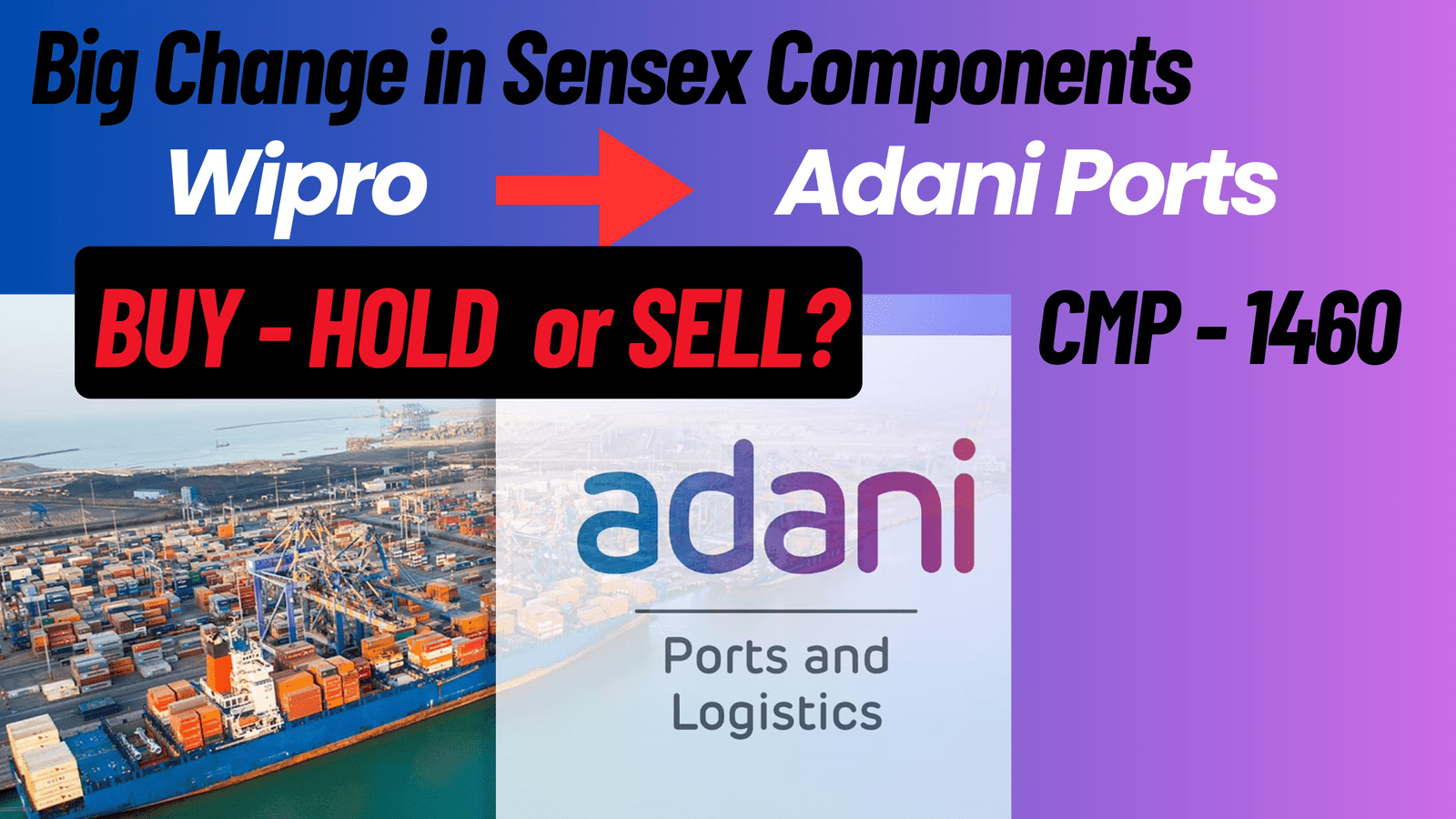
Adani Ports Joins Sensex: Is It a Good Bet Now?
Adani Ports and Special Economic Zone Ltd. (APSEZ), one of India’s leading players in ports and logistics, is set to replace Wipro in the BSE Sensex, according to a recent report by Times of India (TOI). This significant development has sparked interest among investors, leading to questions about whether Adani Ports is a good investment at this juncture. Let’s delve into its fundamental and technical analysis to address these questions comprehensively.
Fundamental Analysis
Ownership Structure and Investor Confidence
From March 24 to December 23, Adani Ports’ ownership structure has shown notable changes:
- Promoter Holdings: Remained steady at 65.89%, with a year-on-year increase of 4.86%, indicating strong confidence from major shareholders.
- Pledged Shares: Slight uptick from 1.70% to 1.72%, marking a year-on-year decrease of 2.96% and a marginal quarter-on-quarter decrease of 0.02%.
- Foreign Institutional Investors (FII): Holdings slightly declined from 14.98% to 14.72%, a year-on-year decrease of 3.01%, despite a quarterly increase of 0.26%, suggesting fluctuating foreign interest.
- Domestic Institutional Investors (DII): Holdings also saw a decrease from 11.85% to 11.63%, showing a year-on-year drop of 1.02% and a quarterly decline of 0.22%.
These shifts highlight stability among promoters and varying levels of institutional investor confidence in Adani Ports.
Market Performance and Valuation
With a market capitalization of ₹3,20,932 Cr., Adani Ports has delivered nearly 99.24% return over the past year, with its current market price at ₹1456.65. The stock has ranged from a low of ₹705 to a high of ₹1,621 over the past 52 weeks.
- PE Ratio: 39.57, matching the sector average.
- P/B Ratio: 6.06.
- Dividend Yield: 0.34%.
- Return on Equity (ROE): 15.32%.
These metrics suggest that Adani Ports is reasonably valued within its sector.
Revenue and Profit Growth
Adani Ports earns 90.43% of its revenue from ports, with the remaining 9.57% from other business products. The company’s net profit grew by 76.2% year-on-year, reaching ₹2,039 Cr., while net operating profit declared was ₹4,029 Cr., a 23.2% year-on-year increase. However, there was a quarter-on-quarter decline of 7.64%.
Technical Analysis
Relative Strength Index (RSI):
- Daily RSI: 56
- Weekly RSI: 66
- Monthly RSI: 80
The RSI indicates that the stock is in bullish territory, especially on a monthly basis.
Exponential Moving Average (EMA): Follow VLA Ambala SEBI RA here on telegrams here – https://t.me/SMTStockMarketToday
- 20 Days EMA: Trading 9% above its 20 Days EMA on the weekly time frame and 2.90% above on the daily time frame.
These figures suggest potential for a pullback, possibly retesting the ₹1310 to ₹1390 range in the short term.
Investment Approach Follow VLA Ambala SEBI RA here on telegrams here – https://t.me/SMTStockMarketToday
Entry Point and Target:
- Entry: Consider dip buying between ₹1310 to ₹1390 as the current price of ₹1456.65 is relatively high for short-term entry.
- Target: ₹1500 to ₹2000
- Holding Period: 40 to 180 days
- Stop Loss (SL): ₹1200
Conclusion
Adani Ports’ inclusion in the Sensex reflects its robust performance and market confidence. Fundamentally, the company shows strong promoter confidence and significant profit growth, albeit with some fluctuations in institutional holdings. Technically, the stock appears bullish, but a short-term pullback could provide a better entry point.
For mid to long-term investors, Adani Ports seems to be a promising addition to the portfolio, provided they enter at a lower price range and are prepared to hold through market fluctuations. As always, it’s essential to consider individual risk tolerance and investment goals before making any decisions.
Now Lets have some more understanding about Indian Ports markets-
Indian Port Market Outlook: Navigating Growth and Opportunities
The Indian port sector is poised for significant growth, driven by the country’s strategic geographical location, robust economic growth, and government initiatives aimed at enhancing infrastructure. Here’s an in-depth look at the current state and future prospects of the Indian port market.
Market Overview
India’s coastline spans approximately 7,517 kilometers, hosting 12 major ports and over 200 minor and intermediate ports. These ports play a critical role in facilitating international trade, with over 90% of the country’s trade by volume and 70% by value being conducted through maritime transport.
Key Drivers of Growth
- Government Initiatives:
- Sagarmala Programme: A flagship initiative aimed at promoting port-led development by modernizing existing ports and developing new ones, improving port connectivity, and enhancing logistics.
- National Maritime Development Programme (NMDP): Focuses on capacity augmentation and modernization of port infrastructure.
- Public-Private Partnerships (PPP): Encouraging private sector participation in port development and operations to enhance efficiency and capacity.
- Economic Growth:
- India’s GDP growth and increasing industrial activities are boosting the demand for maritime transport.
- The rise in manufacturing and export-oriented industries is driving higher cargo volumes through ports.
- Trade Agreements:
- Bilateral and multilateral trade agreements with various countries are expanding trade volumes, necessitating improved port infrastructure and capacity.
- Technological Advancements:
- Implementation of advanced technologies such as automation, digitization, and blockchain in port operations to enhance efficiency and reduce turnaround times.
Challenges
- Infrastructure Deficit:
- Despite various initiatives, many Indian ports still face infrastructural challenges, including inadequate berthing facilities, insufficient depth for larger vessels, and outdated handling equipment.
- Regulatory Hurdles:
- Complex regulatory frameworks and procedural delays can hinder port development and operational efficiency.
- Environmental Concerns:
- Ports must address environmental issues such as pollution, coastal erosion, and habitat disruption while expanding and modernizing facilities.
Future Prospects
- Capacity Expansion:
- Ongoing and planned projects under the Sagarmala Programme and other initiatives are expected to significantly increase port capacity, accommodating larger vessels and higher cargo volumes.
- Enhanced Connectivity:
- Improved road, rail, and inland waterway connectivity to ports will facilitate smoother and faster cargo movement, reducing logistics costs.
- Privatization and Investment:
- Increased privatization and foreign direct investment (FDI) in port infrastructure are likely to drive technological advancements and operational efficiencies.
- Sustainability Focus:
- Ports are increasingly adopting sustainable practices, including the use of renewable energy, waste management, and green logistics solutions to minimize environmental impact.
- Integrated Logistics:
- Development of integrated logistics parks and multimodal logistics hubs near ports to streamline cargo handling and distribution, enhancing overall efficiency.
Conclusion
The Indian port sector is on a trajectory of robust growth, backed by strategic government initiatives, economic expansion, and technological advancements. While challenges remain, the concerted efforts towards capacity expansion, infrastructure modernization, and enhanced connectivity are expected to position India as a significant player in global maritime trade. Investors and stakeholders can look forward to promising opportunities in this dynamic and evolving market.
Vijay Laxmi aka VLA Ambala is SEBI registered Research Analyst and her research and view are being published in various media platforms as well- Check here – https://smtstockmarkettoday.com/pr-and-media/
Follow VLA Ambala SEBI RA here on telegrams here – https://t.me/SMTStockMarketToday

